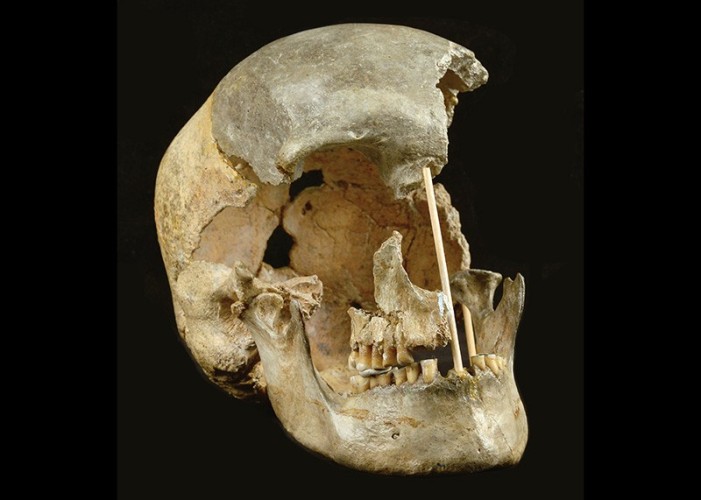
surprisingly recent Neanderthal ancestry
Ewen Callaway
Published:10 Apr 2021, 11:58 AM

surprisingly recent Neanderthal ancestry
Scientists have sequenced the oldest Homo sapiens DNA on record, showing that many of Europe’s first humans had Neanderthals in their family trees. Yet these individuals are not related to later Europeans, according to two genome studies of remains dating back more than 45,000 years from caves in Bulgaria and the Czech Republic1,2.
The research adds to growing evidence that modern humans mixed regularly with Neanderthals and other extinct relatives, says Viviane Slon, a palaeogeneticist at the University of Tel Aviv in Israel. “It’s different times, different places, and it happens again and again.”
The genetic history of the earliest humans in Europe and Asia has been blurred. Although researchers have sequenced DNA from Neanderthals and other extinct human relatives dating as far back as 430,000 years, there is a scarcity of genetic information from the period between around 47,000 and 40,000 years ago, known as the Initial Upper Palaeolithic, and no Homo sapiens DNA at all from before this period. Genomes belonging to humans from Siberia and Romania showed no connection to later waves of Europeans, but a 40,000-year-old individual from China is a partial ancestor of modern East Asian people.
Like all present-day people whose ancestry isn’t solely African, these early Eurasians carried Neanderthal DNA. Researchers thought that probably originated from mixing between the groups in the Middle East 50,000–60,000 years ago. But a 2015 study3 of the genome of the 40,000-year-old Romanian individual, from a site called Peștera cu Oase, held a surprise: a Neanderthal ancestor in the past four to six generations, suggesting that humans interbred with Neanderthals in Europe, too.
It was not clear from the Oase man’s genome whether interbreeding was common in Europe. He lived around the time when Neanderthal populations, already sparse, were beginning to vanish from the region.
Genetic mixture
The latest genome studies, both published on 7 April, clarify the relationships between Europe’s first modern humans, later Homo sapiens and Neanderthals, but also throw up some new questions. One study, in Nature1, is based on a tooth and fragmentary remains from Bacho Kiro Cave in Bulgaria; the other, in Nature Ecology and Evolution2, looks at a nearly complete skull from a cave known as Zlatý kůň in the Czech Republic.
The three oldest Bacho Kiro individuals, dated to between 45,900 and 42,600 years old, all had recent Neanderthal forebears, reports a team led by molecular biologist Mateja Hajdinjak and evolutionary geneticist Svante Pääbo, both at the Max Planck Institute for Evolutionary Anthropology (MPI–EVA) in Leipzig, Germany. The genomes of modern non-Africans usually harbour about 2% Neanderthal ancestry, but the Bacho Kiro individuals had slightly more at 3.4–3.8%, and the chromosome segments — which shorten in successive generations — were considerably longer.
By measuring these segments, the researchers estimated that the Bacho Kiro individuals had Neanderthal ancestors as recently as the past six or seven generations — and probably in Europe, not the Middle East. “We saw these huge chunks. It was completely amazing,” says Hajdinjak, who is now at the Francis Crick Institute in London and was part of the team that identified the same patterns in the Oase man’s genome. “What are the chances of finding them again?”
The Zlatý kůň woman’s Neanderthal ancestry goes back considerably longer: 70–80 generations, or perhaps 2,000–3,000 years, says Johannes Krause, a palaeogeneticist at the MPI–EVA who co-led the study. His team could not date the skull accurately because of contamination. But on the basis of its Neanderthal ancestry, Krause suspects it is well over 45,000 years old, and in the same ballpark as the oldest remains from Bacho Kiro. “We do have, now, some of the oldest human genomes out there,” adds Hajdinjak.
Tracing the lineage
The oldest individuals from Bacho Kiro and the Zlatý kůň female are not related to later Europeans, ancient or modern, meaning that their lineages must have disappeared from the region. But, to their surprise, Hajdinjak and her colleagues found that the Bacho Kiro people shared a connection with contemporary East Asians and Native Americans. Hajdinjak suggests that the Bacho Kiro remains represent a population that once lived across Eurasia, but vanished from Europe and lived on in Asia.
The fact that several humans from Bacho Kiro had very recent Neanderthal relatives suggests that the groups mixed routinely in Europe, says Marie Soressi, an archaeologist at the University of Leiden in the Netherlands who plans to examine European archaeology through this lens.
Stone tools and other artefacts common to the Initial Upper Palaeolithic — and distinct from typical Neanderthal and later human toolkits — could be a product of cultural exchanges or even mixed populations, she says. “We really want to better understand what happened, what was the historical process and how peaceful were those encounters.”
*Author, the article published in Nature.